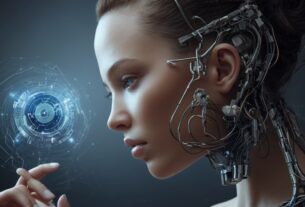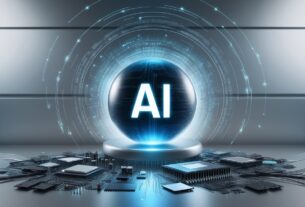Introduction
Generative Artificial Intelligence:
In the rapidly evolving world of technology, few innovations have captured the public imagination and industrial attention quite like generative artificial intelligence (AI). Unlike traditional AI, which analyzes data to make predictions or automate tasks, generative AI takes a bold leap forward: it creates. Whether it’s generating realistic images, crafting compelling text, composing music, or designing entirely new molecules for drug discovery, generative AI represents a transformative shift in how we interact with machines. But what exactly is it, how does it work, and what are the implications of this powerful technology?
What is Generative AI?
At its core, generative AI refers to algorithms that can produce new content based on training data. This content can take many forms, including text, images, audio, video, or even code. The technology behind generative AI often involves deep learning models, particularly those built using architectures such as Generative Adversarial Networks (GANs) and Transformers.
GANs, introduced by Ian Goodfellow in 2014, consist of two neural networks: a generator that creates content and a discriminator that evaluates it. Over time, the generator improves its outputs to fool the discriminator, resulting in increasingly realistic content. Transformers, popularized by models like OpenAI’s GPT (Generative Pre-trained Transformer), rely on massive datasets and attention mechanisms to generate coherent and contextually relevant text.
Applications Across Industries
Generative AI’s versatility has led to widespread adoption across various sectors:
- Content Creation: Writers and marketers use tools like ChatGPT to brainstorm ideas, draft articles, and generate social media content. Visual artists and designers employ tools such as DALL-E or Midjourney to create stunning visuals from textual prompts.
- Healthcare and Biotechnology: Generative models are revolutionizing drug discovery by predicting molecular structures with therapeutic potential. They also assist in medical imaging and diagnosis.
- Gaming and Entertainment: Game developers leverage generative AI to create complex environments, character designs, and dialogue systems. AI-generated music and video content are becoming more common in entertainment production.
- Finance: In the financial sector, generative AI aids in generating realistic synthetic data for modeling and risk assessment. It can also craft personalized financial reports.
- Education: Educators and edtech companies use generative AI to create customized learning materials, interactive lessons, and AI tutors that adapt to individual learning styles.

The Human Touch in Machine Creativity
One of the most fascinating aspects of generative AI is its ability to mimic human creativity. However, it’s essential to recognize that while these models can produce human-like content, they do not possess consciousness or genuine understanding. Instead, they identify patterns in data and generate outputs that statistically resemble what they have seen before.
This distinction matters, especially in creative fields. For instance, while a generative model can write a poem or paint a picture, the intent and emotional resonance behind human-created art remain uniquely human. Yet, this technology provides powerful tools for augmenting human creativity, allowing individuals to explore new ideas and push artistic boundaries.
Ethical and Societal Implications
With great power comes great responsibility. The rise of generative AI has sparked important ethical debates:
- Misinformation and Deepfakes: AI-generated content can be used to spread false information or create convincing deepfake videos that mislead viewers. This poses significant challenges for media integrity and public trust.
- Intellectual Property: As generative AI can mimic existing styles or content, questions arise about ownership and copyright. Who owns the output of an AI model trained on copyrighted material?
- Bias and Fairness: Generative models learn from data, and if that data is biased, the outputs will reflect those biases. This can perpetuate harmful stereotypes or discriminatory practices.
- Job Displacement: Automation through AI has already impacted jobs in various industries, and generative AI could accelerate this trend, particularly in creative and white-collar professions.
Addressing these concerns requires collaborative efforts from technologists, policymakers, ethicists, and the public. Transparency in model development, clear regulations, and ethical guidelines are essential to harness the benefits of generative AI while minimizing harm.
Advancements and Future Directions
Generative AI is advancing at a breakneck pace. Models are becoming more sophisticated, multimodal (able to process and generate multiple types of content), and capable of understanding more complex prompts. Key areas of ongoing research and development include:
- Model Efficiency: Improving the energy efficiency and speed of generative models to make them more accessible and environmentally sustainable.
- Alignment and Safety: Ensuring AI behaves in ways aligned with human values, avoids harmful outputs, and can be safely deployed in real-world settings.
- Personalization: Enhancing the ability of AI systems to tailor content and interactions to individual users, creating more meaningful and relevant experiences.
- Interdisciplinary Integration: Combining generative AI with fields like neuroscience, linguistics, and social sciences to better understand and improve how these systems work.
Human-AI Collaboration: A New Creative Frontier
Rather than replacing human ingenuity, generative AI has the potential to enhance it. We are entering an era of co-creation, where humans and machines work together to solve problems, tell stories, and innovate in ways previously unimaginable.
For example, in architecture, AI can propose novel structural designs based on functional and aesthetic criteria, while architects refine and contextualize these ideas. In scientific research, generative models can suggest hypotheses or analyze complex data, accelerating discovery. In education, AI tutors can offer personalized guidance, while teachers focus on mentorship and holistic development.
This collaborative approach fosters a symbiotic relationship, where each party brings unique strengths to the table: the machine’s capacity to process and generate vast amounts of data, and the human’s ability to empathize, judge, and intuit.
Challenges Ahead
Despite its promise, generative AI is not without hurdles. Ensuring inclusivity and equity in access to these technologies is crucial to prevent widening the digital divide. There is also a growing need for digital literacy, so individuals can critically engage with AI-generated content and understand its limitations.
Moreover, as these tools become more powerful, the line between real and artificial becomes increasingly blurred. Society must grapple with new philosophical questions about authenticity, creativity, and even identity. What does it mean for something to be “created” when the creator is an algorithm? How do we attribute meaning or value to machine-generated content?
Conclusion
Generative artificial intelligence stands at the intersection of innovation, creativity, and ethics. It challenges our understanding of what machines can do and offers new ways to express, explore, and engage with the world. As with any powerful technology, its true impact will depend not only on the capabilities of the machines but on the choices we make as a society.
By fostering responsible development, encouraging inclusive dialogue, and embracing the potential of human-AI collaboration, we can ensure that generative AI becomes a tool for empowerment and positive transformation. The story of generative AI is still being written—and we all have a role in shaping its next chapter.
Generative Artificial Intelligence:
Generative AI: Frequently Asked Questions (FAQ)
1. What is Generative AI?
Generative AI refers to a class of artificial intelligence models designed to create new content—such as text, images, music, video, or code—by learning from existing data. Unlike traditional AI, which focuses on prediction or classification, generative AI generates original content based on patterns in the data it was trained on.
2. How does Generative AI work?
Generative AI typically relies on deep learning techniques. Two of the most common architectures are:
- Generative Adversarial Networks (GANs): These use two neural networks—a generator and a discriminator—that compete with each other to create increasingly realistic outputs.
- Transformers: Used in models like GPT, these rely on large datasets and attention mechanisms to generate coherent, context-aware content, especially in natural language processing.
3. What are the main applications of Generative AI?
Generative AI is widely used across various industries:
- Content Creation: Text generation, image creation, video synthesis, and music composition.
- Healthcare: Drug discovery, medical imaging, and diagnostic assistance.
- Gaming & Entertainment: Environment design, character development, and story generation.
- Finance: Synthetic data generation, risk modeling, and personalized reporting.
- Education: Creation of adaptive learning materials and AI tutors.
4. Can Generative AI be truly creative?
While generative AI can mimic human creativity and produce impressive outputs, it doesn’t possess consciousness or intent. Its “creativity” is based on learned patterns from data. It can inspire or assist human creativity, but the emotional depth and intentionality behind art remain human traits.
5. What are some ethical concerns associated with Generative AI?
Several ethical and societal issues have emerged:
- Misinformation and Deepfakes: AI-generated content can be used maliciously to spread false narratives.
- Copyright and Ownership: Questions arise over who owns AI-generated content, especially when models are trained on copyrighted materials.
- Bias and Discrimination: Models can reflect and perpetuate biases present in training data.
- Job Displacement: Automation through generative AI may impact creative and knowledge-based jobs.
6. How can we mitigate the risks of Generative AI?
Mitigation strategies include:
- Promoting transparency in how models are trained and used.
- Developing ethical guidelines and regulatory frameworks.
- Ensuring diversity in training data to minimize bias.
- Encouraging public awareness and digital literacy so users can critically assess AI-generated content.
7. How is Generative AI used in human-AI collaboration?
Generative AI is becoming a powerful co-creative tool. For example:
- In architecture, AI proposes design options, which humans refine.
- In science, AI helps generate hypotheses and analyze complex datasets.
- In education, AI tutors can provide tailored assistance while teachers focus on mentoring.
8. What are the limitations of Generative AI?
Some limitations include:
- Lack of true understanding or consciousness.
- Potential to generate incorrect or misleading information.
- Heavy computational requirements.
- Difficulty in interpreting how and why a model produced a given output.
9. What is the future of Generative AI?
Key directions in development include:
- Multimodal Models: Systems that can understand and generate across multiple types of media (e.g., text + image).
- Efficiency Improvements: Reducing the environmental impact of training large models.
- Better Alignment: Making sure models behave ethically and in alignment with human values.
- Greater Personalization: Tailoring AI experiences to individual users more effectively.
10. Will Generative AI replace human creativity?
No. Rather than replacing human creativity, generative AI is more likely to augment it. It can accelerate workflows, inspire new ideas, and make creative processes more accessible. The future points toward co-creation, where humans and AI work together.
11. What are deepfakes, and why are they concerning?
Deepfakes are highly realistic fake videos or audio created using generative AI, often indistinguishable from real footage. They can be used maliciously for misinformation, impersonation, or manipulation, raising serious ethical and legal issues.
12. Who is responsible for AI-generated content?
Responsibility can vary depending on usage:
- Developers must ensure the technology is built ethically.
- Users are responsible for how they deploy or share AI-generated content.
- Policy makers should define clear regulations on ownership and accountability.
13. Is AI-generated content protected by copyright?
This is an ongoing legal debate. In many jurisdictions, content without human authorship may not qualify for copyright protection. If AI is trained on copyrighted data, using its outputs can raise additional legal and ethical questions.
14. How do we ensure equitable access to Generative AI?
Efforts to ensure equity include:
- Open access to tools and datasets.
- Inclusive model development that reflects diverse perspectives.
- Public funding for AI literacy programs.
- Policies that prevent monopolization by large tech firms.
15. How can individuals prepare for a future with Generative AI?
- Stay informed about AI trends and impacts.
- Develop digital literacy to evaluate AI content critically.
- Learn to work with AI tools, especially in creative or technical fields.
- Engage in ethical conversations about how AI should be used.
Read also :




